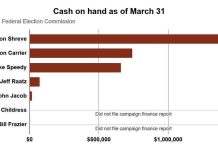What some Bartholomew County officials are describing as the weaning of small nonprofit agencies from local public money has begun.
An across-the-board 10 percent cut in funding from last year for five organizations has been approved by the Bartholomew County Commissioners.
Those groups are the Bartholomew County 4-H Clubs, Area 11 Agency on Aging, Mill Race Center, Heritage of Hope Inc. and the Bartholomew County Historical Society.
The action was no surprise to the nonprofits, who were warned three months ago.
When it appeared the county might face a $3.9 million budget shortfall during the start of the budget process in July, a few county council members said they feared there might not be any county funds available for nonprofits in 2016.
After several weeks of cost-cutting efforts, county commissioner Larry Kleinhenz told the council in early October he expected payments to many of those organizations would drop about 10 percent this year.
Traditionally, county officials have financially supported these organizations because they help county residents and provide valuable services.
Unless new revenue sources can be secured, however, those amounts provided to nonprofits will increasingly diminish in 2017 and beyond, Kleinhenz said.
When compared to last year, the $2.21 million in county funds available to the commissioners this year represents a 53.4 percent drop from 2015, according to figures provided by their office.
In addition, the state-mandated amounts the commissioners are required to pay for services to the disabled and mentally ill went up almost 3 percent this year to $649,034.
The additional $19,405 necessary to pay for those two services is substantially higher than the $1,662 in savings stemming from the cuts to the five smaller nonprofits.
Back in 2008, a number of local nonprofit agencies received significant amounts of their funding through government, said Mark Stewart, president of United Way of Bartholomew County.
But after Indiana lawmakers put a property tax cap on local funding in 2010, the amount of money available to the county began to drop significantly, Kleinhenz said.
That resulted in an immediate 50 percent cut in money provided by the commissioners to the five agencies.
Since then, those social service agencies tried to replace lost revenue through private and corporate donations or from grants at the state and federal level, Stewart said.
Although new fundraising events have been launched in recent years, there has been concern that each new event created for one agency ends up taking away funding from another, said Dan Mustard, director of operations for Mill Race Center.
“We in Columbus are very philanthropic, but the community has its limits,” Stewart said. “Amounts raised through philanthropy are usually noticeably smaller than through the government.”
But during the past six years, funding available for social services at the state and federal levels has shrunk to its lowest level in 22 years, Stewart said. That has forced almost all local nonprofits to operate extremely lean and become innovative, he said.
“Most people in this line of work realized long ago you can never rest on funding from any single source because none of it is stable,” Mustard said. “You always have to be diverse and look for new revenue streams, because none of it is stable.”
Since the cuts made at the county level are comparatively small, Mustard said he doubts “anyone’s world is being rocked.”
But the biggest damage may be suffered by organizations with matching grants, Stewart said. As an example, a $450 drop in funding for the Agency on Aging could result in a $900 drop in revenue though a federal program, he said.
“These (drops in government funding) seem to be cyclical,” Stewart said. “But that doesn’t give much reassurance in 2016, and there’s a lot of stress on the system right now.”




